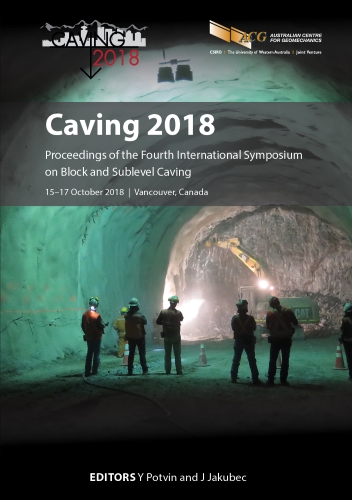Leinster cave seismic risk management: a block cave solution

|
Authors: Hopkins, M; Rimmelin, R; Landon, A |
DOI https://doi.org/10.36487/ACG_rep/1815_46_Hopkins
Cite As:
Hopkins, M, Rimmelin, R & Landon, A 2018, 'Leinster cave seismic risk management: a block cave solution', in Y Potvin & J Jakubec (eds), Caving 2018: Proceedings of the Fourth International Symposium on Block and Sublevel Caving, Australian Centre for Geomechanics, Perth, pp. 591-606, https://doi.org/10.36487/ACG_rep/1815_46_Hopkins
Abstract:
On 31 October 2013, production at Leinster’s sublevel caving (SLC) operations were suspended following a significant mining-related seismic event that caused unforeseen levels of damage to underground workings. The event occurred when mining was taking place in an area known as the 11 Level Fold, approximately 1,100 m below surface. An assessment of the seismic risk following the 2013 event determined that it was too significant to continue with the SLC operations. Therefore, the SLC operations were not restarted and alternate mining methods would need to be investigated to address the exposure of personnel to the effects of the seismic concentration associated with the 11 Level Fold area. The proposed solution avoids the zones of highest seismic activity by transitioning to a block cave mining method and locating a production footprint at a level where interaction with the previous SLC and the 11 Level Fold can be avoided. This design is based on an advance undercut and excavation of 22 drawbells. Due to a significant regional shear that vertically bisects the orebody, it is expected that a ‘chimney’ cave will develop, thereby connecting with the previous sublevel cave column. The design will maintain critical infrastructure, such as the existing shaft, and use the current decline infrastructure to access the new production level. This work shows how high seismic risk can be managed by defining seismic exclusion zones and employing a mine design and mining method that best accounts for the geotechnical environment.
Keywords: seismic risk, sublevel caving, block caving, mine design
References:
Barton, N, Lien, R & Lunde, J 1974, ‘Engineering classification of rock masses for the design of tunnel support’, Rock Mechanics, vol. 6, no. 4, pp. 189–236.
Beck, D 2013, BHP Billiton Nickel West: SLX Induced Seismic Hazard: Global Coupled Cave Flow (NCA) Rock Mass Deformation (DFE) Analysis, unpublished report, Beck Engineering, Chatswood West.
Beck, D 2017, Extraction of the Main Disseminated Orebody Below 11L by the Block Caving Method, unpublished report, Beck Engineering, Chatswood West.
Hoek, E, Kaiser, PK & Bawden, WF 1995, Support of Underground Excavations in Hard Rock, A.A. Balkema, Rotterdam.
Laubscher, DH 1990, ‘A geomechanics classification system for the rating of rock mass in mine design’, Journal of the South African Institute of Mining and Metallurgy, vol. 90, no. 10, pp. 257–273.
Lessard, JF & Heal, D 2009, ‘Evolution of ground support practices within the development cycle at Perseverance Mine’, in PM Dight (ed.), Proceedings of the First International Seminar on Safe and Rapid Development Mining, Australian Centre for Geomechanics, Perth, pp. 181–198.
Levkovitch, V, Beck, D & Reusch, F 2013, ‘Numerical simulation of the released energy in strain-softening rock materials and its application in estimating seismic hazard in mines’, in A Malovichko & DA Malovichko (eds), Proceedings of the 8th International Symposium on Rockbursts and Seismicity in Mines, Geophysical Survey of Russian Academy of Sciences, Obninsk, and Mining Institute of Ural Branch of Russian Academy of Sciences, Perm, pp. 259–266.
Struthers, MA, Turner, M, Jenkins, P & McNabb, K 2000, ‘Rock mechanics design and practice for squeezing ground and high stress conditions at Perseverance mine’, Proceedings of MassMin 2000, The Australasian Institute of Mining and Metallurgy, Melbourne, pp. 755–764.
Thin, I, Stone, C, Beck, D & Hastings, N 2006, ‘Perseverance mine: past, Present and deeper - Part III’, in Y Potvin (ed.), Proceedings of the 2nd International Seminar on Strategic Versus Tactical Approaches in Mining, Australian Centre for Geomechanics, Perth, Section 7, pp. 1–15.
Thin, I 2008, Definition Phase Study – Perseverance Deeps Project – Section 6 Geotechnical, unpublished report.
Tyler, DB & Werner, M 2004, ‘A case study of ground support improvement at Perseverance mine’, in E Villaescusa & Y Potvin (eds), Proceedings of the Fifth International Symposium on Ground Support: Ground Support in Mining and Underground Construction, Taylor & Francis Group, London, pp. 53–63.
Wood, P, Jenkins, P & Jones, I 2000, ‘Sub-level cave drop down strategy at Perseverance mine, Leinster Nickel Operations’, Proceedings of MassMin 2000, The Australasian Institute of Mining and Metallurgy, Melbourne, pp. 517–526.
© Copyright 2025, Australian Centre for Geomechanics (ACG), The University of Western Australia. All rights reserved.
View copyright/legal information
Please direct any queries or error reports to repository-acg@uwa.edu.au
View copyright/legal information
Please direct any queries or error reports to repository-acg@uwa.edu.au
